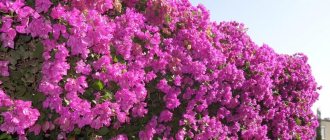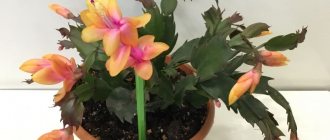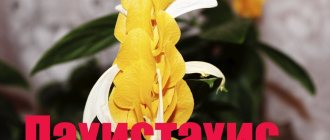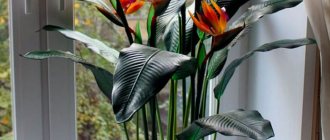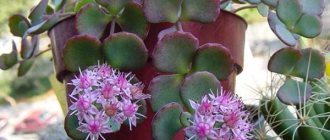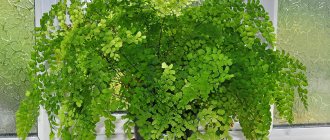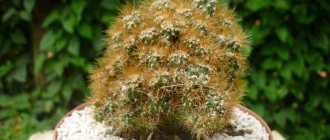floravdome.ru > Beautiful flowering trees and shrubs > Bougainvillea (Bougainvillea)
Beautiful, generously blooming bougainvillea , always attracting attention and arousing admiration, comes from South America. It has taken root well in Europe, North Africa, and has spread throughout Southeast Asia. In warm and mild climates, this liana-like plant grows rapidly, reaching a length of more than 15 meters, blooms profusely and luxuriantly almost all year round, and feels great in the garden, in the wild, and in the city.
But the luxurious appearance of bougainvillea during the flowering period is given not by the flowers at all, but by the brightly colored bracts, heart-shaped, pointed leaves surrounding small light flowers.
The most famous is the naked bougainvillea (B. Glabra Choisy) and its numerous hybrids of various colors - from rich carmine and purple flowers to soft pink and white.
At home, bougainvillea is grown quite simply, does not require particularly difficult conditions, reproduces easily, and blooms well in the summer. An important point in growing is regular pruning of the plant.
Bougainvillea glabra
Bougainvillea glabra
Rest period
Weak dormant period - autumn - winter. At this time, it is recommended to gradually reduce the plant’s daylight hours to 5-6 hours, and lower the air temperature to +7o - +10o.
Watering is moderate. Do not allow the soil to dry out and keep it moderately moist. During the dormant period, bougainvillea undergoes foliage renewal - the plant sheds almost all its old leaves in order to again grow a lush crown during the growing season.
♦ Proper maintenance of the plant during the dormant period contributes to its active growth and lush flowering in the new season.
With proper maintenance, bougainvillea grows actively and requires periodic pruning, both to give a neat shape to the crown of the plant and to stimulate the growth of new shoots and flowering.
Pruning is carried out in early spring, with the resumption of the growing season - dry and overgrown branches are cut to the required length, sometimes by a third or more, which stimulates the growth of new shoots with flower buds and bushiness.
In autumn, branches with faded bracts, weak and dried shoots are pruned.
Branches with young buds are left.
Seeds
The seeds are planted in peat soil and placed in greenhouse conditions at a temperature of +25o - +28o.
Seeds germinate very slowly - the first seeds appear no earlier than after 2 months.
A new plant does not always retain varietal characteristics.
By cuttings
Healthy semi-lignified cuttings up to 10 cm with apical leaves are treated with a root formation stimulator, for example Kornevin, and planted in peat soil or a mixture of peat and sand. They put it in a greenhouse and in a bright, warm (+25o – +26o) place. After the formation of a strong root system, the new plant is transplanted into a separate pot.
Shoots also take root well in water with the addition of Epin (or another growth stimulant).
Plant characteristics
In the brief description, the Brazilian flower is defined as a tropical vine or shrub with:
- bright bracts;
- small apical flowers;
- flexible, curly shoots. The stems have thorns;
- pubescent oblong or ovate leaves.
When grown at home, the “miracle flower” does not bear fruit, grows quickly and can grow 2-3 meters in a season without pruning.
Replanting bougainvillea
Young plants grow quite actively and require annual replanting, adults are replanted as the soil becomes depleted or the pot becomes full.
♦ Choose a tall pot. When replanting, the pot should be several centimeters larger than the old one. If you choose a pot that is too large, “not the right size,” then the plant, first of all, will begin to grow roots to the detriment of the growth of the above-ground part and flowering.
♦ Transplantation is carried out before the growing season in mid-late March.
♦ The soil is loose and nutritious with the following composition: turf soil, humus, sand, peat in approximately equal proportions. To prevent root diseases, you can add charcoal or ash.
♦ When replanting, damaged roots are removed.
♦ Be sure to add drainage to the bottom of the pot.
♦ To reduce damage to the fragile root system, replanting is done by transshipment: water the plant well and carefully remove the entire earthen ball with roots from the old pot, place the plant in a new pot with a layer of drainage and a small amount of soil and add soil until the container is completely filled.
Spider mite - the plant is entangled in cobwebs.
♦ The plant is washed and treated with a solution of laundry soap. Spray the plant with Aktara.
Mealybug - the leaves dry out, pests in the form of small cotton balls are noticeable on different parts of the plant.
♦ Pests are collected. Treat the leaves with a solution of laundry soap and spray with infusion of garlic or wormwood. Treated with insecticides - Actellik, Fitoverm, Fazol.
If possible, damaged parts are removed.
Aphids - leaves dry out and fall off, pests are visible mainly on the underside of the leaves.
♦ Treat the leaves with a solution of laundry soap and spray with infusion of garlic or wormwood. Treated with insecticides – Actellik, Aktara.
Soft light spots appear on the leaves - violation of the watering regime - excessive. Water the plant only when the top layer of soil dries out; if necessary, check for drying at a depth of several centimeters.
♦ Leaves turn yellow - excessive watering or cold water. In summer, water only when the top layer of soil dries out. Use warm, settled water. In winter, reduce watering to a minimum.
♦ Leaves turn pale and become smaller – lack of nutrients.
♦ Leaves dry – dry air. Spray the leaves in the morning; on hot days, it is possible to spray water over the plant without getting on the leaves.
♦ Does not bloom for a long time - the dormant period is not sufficiently provided; lack of heat, light, improper watering; excess nitrogen fertilizers.
Bougainvillea has many varieties, representing almost all shades of red, purple, lilac, and yellow. There are varieties of mixed colors, for example, white and pink.
Varieties with double flowers and variegated ones have been bred.
The photographs below show some varieties of this beautiful plant.
Bougainvillea glabra Sanderiana
Bougainvillea Snow Purple
Bougainvillea Double Red
Bougainvillea Tomato Red
Bougainvillea Pedro
Bougainvillea Scarlet Glory Orange
Bougainvillea California Gold
Golden Tango Bougainvillea
Bougainvillea Yellow Queen
Bougainvillea Cherry Blossom
Bougainvillea Limberlost Beauty
Bougainvillea Strawberry Lace
Bougainvillea Jamaica White
Bougainvillea Bougainvillea Thai Gold
Share link:
Rate the article!
[Total: 2 Average: 5]
Garden varieties
About 15 species of bougainvillea are known and cultivated. Of which three are the founder of all other varieties and hybrids - B. Golaya, B. Prekrasnaya and B. Peruvian. The new species are distinguished by multi-colored bracts, the shape of the leaves and their edges. The still unattainable dream is to obtain bougainvillea without thorns and with blue flowers.
In warm southern countries, bougainvillea is grown in the garden. There, this heat-loving plant is ubiquitous. The most “northern” climate for gardening is the regions where the temperature at night does not drop below 5 °C.
In Russia, the southern coast of Crimea and the Black Sea coast meet these conditions. In colder regions, it is better to cover the plant for the winter or even move it home to warmer conditions. Of course, bougainvillea in this case is grown in a large pot or tub.
Despite the fact that this plant feels good in the garden with virtually no human intervention, it still needs to be watered regularly. Bougainvillea grows happily on the south-eastern side of the walls, growing along the fence, entwining it like grapes. Old dense thickets of bougainvillea look impressive: white or purple leaf bracts create living caps that descend from the height of the canopy.
Brazilian varieties
B. Naked (Bougainvillea glabra) is a tall variety, reaching up to 5 m in height and having white, yellow, purple or pink bracts. The leaves are dark, glossy, large - up to 10-12 cm in length and 4-6 cm in width. The stem is covered with sparse spines. With the help of pruning, it is possible to form a crown of the desired size and shape. Prefers dry, rocky soils and is widespread in southern Brazil.
B. Naked (Bougainvillea glabra)
B. Peruvian (Bougainvillea peruviana) - was first discovered in 1810 by naturalist and traveler Alexander Humboldt. This species is climbing, does not bush well, and is liana-like. The flowers are yellow, the bracts are purple or crimson. The leaves are ovoid, thin and smaller. Long shoots practically do not produce side branches, so pruning must be done on time to form a crown.
B. Peruvian (Bougainvillea peruviana)
Brazilian varieties are natural and easily cross with each other, forming new species. Breeders take advantage of this circumstance to develop new hybrid forms.
Terry varieties
Terry varieties of bougainvillea are distinguished by dense, smaller bracts, which makes the plant look simply stunning. Here are some terry varieties.
Double Red is one of the most popular and sought after bougainvillea varieties. It is distinguished by bright, non-fading bracts of red or dark crimson color.
Terry variety Double Red
Double Pink is a variety similar to the previous one, differing in the color of the stipules - a variety of shades of pink from light to deep dark.
Terry variety Double Pink
Bougainvillea hybrids
There are many hybrid varieties of this plant. Here are just a few of them:
Aussie Gold
- distinguished by yellow stipules that contrast with dark green leaves.
Hybrid variety Aussie Gold
Australian Gold is somewhat similar to Double Red, but not as rich.
Hybrid variety Australian gold
Australian Pink - Pink bougainvillea caps make a lovely addition to any gazebo.
Hybrid variety Australian Pink
Jamaica White
- huge virgin white stipules.
Bougainvillea variety Jamaica White
Two-color varieties
Two-color plant varieties are very impressive. Their stipules have a double color - usually white and some other color, for example pink.
Snowcap Multi
Variety Snowcap Multi
Miss Universe
Two-color variety Miss Universe
Variegated species
These varieties of bougainvillea are distinguished by the fact that they have heterogeneous leaf color, which is preserved throughout the plant. These species look very unusual, sometimes even confusing which plant is in front of us.
San Diego Red Variegata
San Diego Red Variegata variety
White Sprite
Variety White Sprite
Delta Dawn
Bougainvillea variety Delta Dawn
Flower care at home
In summer, it is advisable to place the flowerpot with a flower on the balcony, protecting it from drafts. Optimum temperature from +22°C +30°C. However, a strong decrease in thermal conditions at the resting stage (up to +7°C) can cause the development of pathogenic microorganisms and further death.
The plant responds favorably to watering with soft, settled water: it is a moisture-loving flower that needs regular abundant moistening and spraying of the foliage on both sides, and this must be done as carefully as possible so that drops do not fall on the petals. Stagnant moisture is also unacceptable for a flower: it causes rotting of the root system. That is why after watering you need to remove excess water from the pan.
For spectacular flowering, bougainvillea should be fed with complex fertilizers at least twice a week. In addition, the intensively developing plant requires regular replanting. The size of the buds under normal conditions is determined by the size of the flowerpot: tightness for the roots provokes a decrease in the growth of the bush and a decrease in the volume of flowering.
The optimal time for replanting is considered to be early spring, the time when the plant awakens from winter rest. An important requirement for planting is the preservation of the roots, which requires great care when carrying out.
After flowering is completed, in order to activate further formation of buds, the shrub needs pruning, with young shoots being shortened by half. In the autumn period, serious pruning of branches is carried out, and during the summer season, light crown formation can be carried out.
Description of the variety
California Gold is considered one of the most beautiful yellow varieties. Golden Bougainvillea tolerates apartment conditions well and blooms luxuriantly in summer and winter. Unfortunately, it is not suitable for outdoor cultivation: lowering the temperature is destructive for Bougainvillea. But at home it will delight the owners with its bright blooms. Can be used for growing bonsai.
This variety is more suitable for experienced gardeners, since the plant is still exotic. Bougainvillea requires good, stable conditions to grow and develop. It is necessary to observe the watering regime, as well as maintain the desired temperature. Failure to comply with the conditions can lead to the death of a delicate flower.
